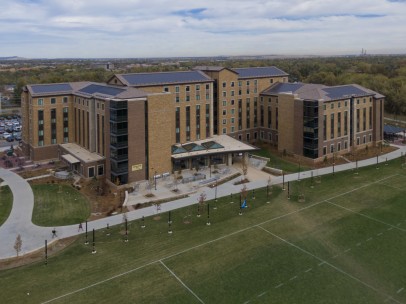Colleges and universities today are looking for sustainable facilities, and a number of them choose to participate in the LEED (Leadership in Energy and Environmental Design) process to obtain a measurable level of sustainability.
LEED is a green building certification program used worldwide. Developed by the non-profit U.S. Green Building Council (USGBC) in 1993, LEED includes a set of rating systems for the design, construction, operation and maintenance of green buildings. The goal of the program is to help building owners and operators be environmentally responsible and use resources efficiently. Buildings can qualify for four levels of certification based on a point system, with higher points earned correlating to greater energy efficiency: Certified (40-49 points), Silver (50-59 points), Gold (60-79 points) and Platinum (80 or more points).
“LEED provides a framework for healthy, highly efficient, and cost-saving green buildings, and university officials choose this framework to substantiate the sustainable level of their facility,” said KWK Principal Paul Wuennenberg. “Attaining a LEED certification demonstrates environmentally responsible building practices.”
KWK Architects recently designed residence halls at the University of Missouri and University of Colorado - Boulder that achieved the highest level of sustainability certification, LEED Platinum.
KWK, along with associate architect Lawrence Group, designed Brooks and Bluford Halls at the University of Missouri in Columbia to achieve a LEED v2009 Platinum certification. While the client requirement for the new 198,000 square-foot, 570-bed residence hall project was LEED Certified minimum, the KWK project team was dedicated to achieving the highest rating within the tight budget, and the team looked to maximize energy efficiency in the buildings to achieve this goal.
The sustainable, energy-saving features of the buildings include total enthalpy heat recovery for the ventilation systems, demand-controlled ventilation using CO2 and occupancy sensors, high-efficiency LED lighting, daylighting controls, occupancy setback control of lighting and HVAC systems, and variable air volume (VAV) kitchen exhaust and makeup air systems. Additionally, the exterior envelopes of the buildings are high performance.
“The University of Missouri boasts a campus-wide system to furnish its buildings with heating, cooling and power. The campus’ steam system is fed by a combined heating and power central utility plant. This plant uses a biomass boiler for steam production. Not only does this biomass boiler produce steam for power through steam turbine generators, it also produces steam for chilled water through steam turbine chillers. Power for the university grid is provided by solar photovoltaic (PVs) arrays and wind turbines. These features, combined with a detailed and realistic building operation schedule, space loads and equipment efficiencies in the building energy model, allowed the project to earn all available points under the Optimize Energy Performance Credit,” said Wuennenberg.
With the site of the residence halls just north of the football stadium, it was important for the project to have a recognizable, sustainability feature on one of the buildings. The design team looked to roof-top solar panels for Brooks Hall; with its large, south-facing sloping roof, it was a good fit for the building.
“Roof-top solar panels on Brooks Hall pre-heat water for the domestic hot water system and provide an important sustainability element for the campus to achieve the LEED Platinum certification,” said Wuennenberg.
At the University of Colorado Boulder, the new 700-bed, seven-story Williams Village North Residence Hall achieved a LEED Platinum v4 certification; the first residence hall of its size in North America to achieve this rating.
Some of the building’s sustainability features include numerous windows to let in natural light, plus windows with electrochromic glazing that automatically adjust the shading level based on the time of day and year. Windows in the student rooms feature magnets that turn the heating and cooling systems on and off when the windows are opened or closed. Vacancy sensors in each room also control lighting and heating and cooling levels depending on when students are in their rooms. A black switch in each student room also turns off “phantom loads” when electronics are left plugged in and not in use.
A pond that uses ditch water from snowmelt supplies the hall with water and saves the campus an estimated 13 million gallons of water per year. Other renewable energy features of the building include solar panels, LED lighting, thermostats in each student room, low-flow toilets and urinals, door closers and a VRF HVAC system.
“A multitude of the energy efficient features we designed into the building focus not only on saving energy, but also encourage students to get involved in energy saving practices,” said Wuennenberg. “The hall features several recycling areas for student trash and floors are grouped into sustainability teams that compete to use the least amount of water and energy. Winning teams are awarded throughout the semester.”





